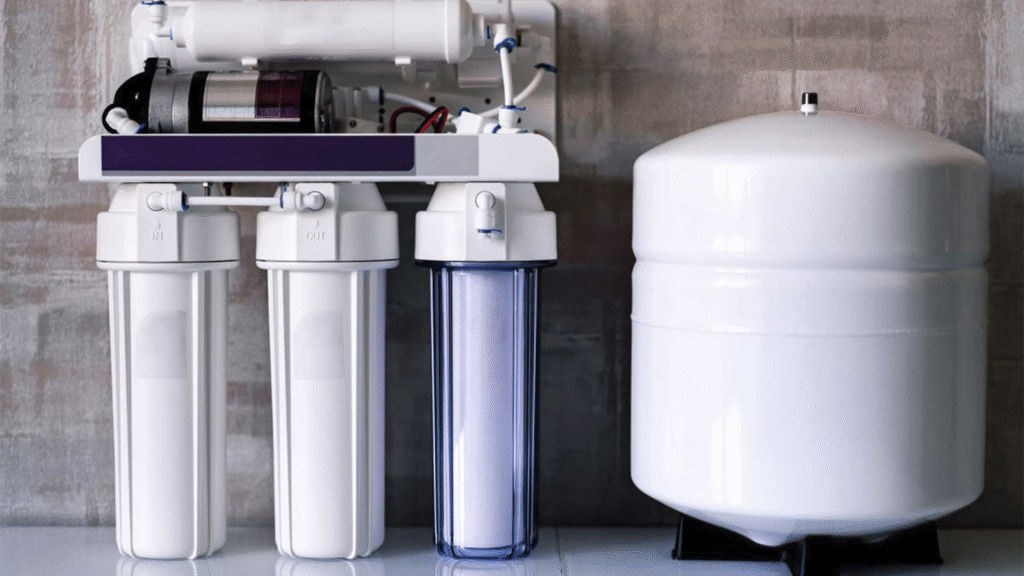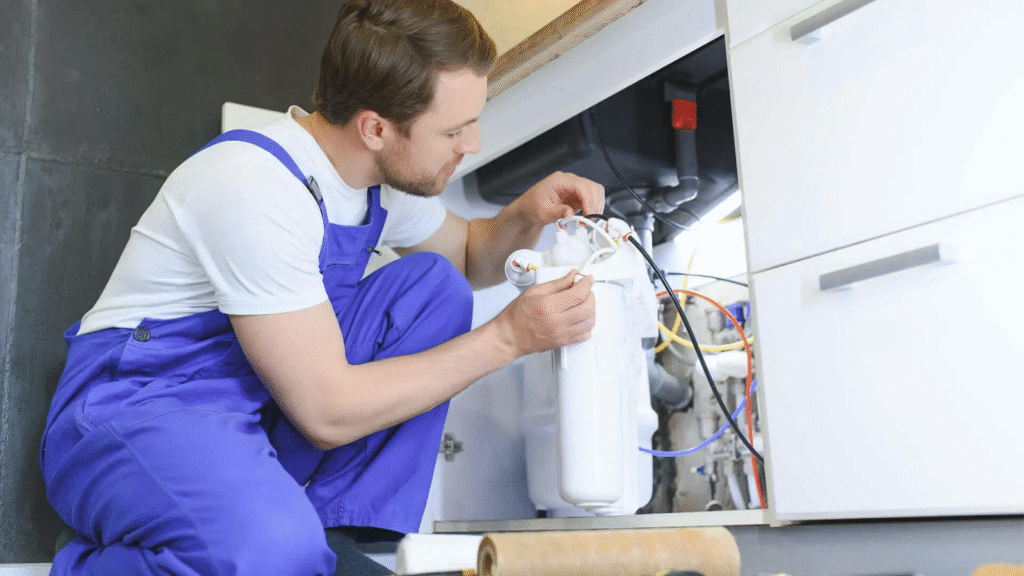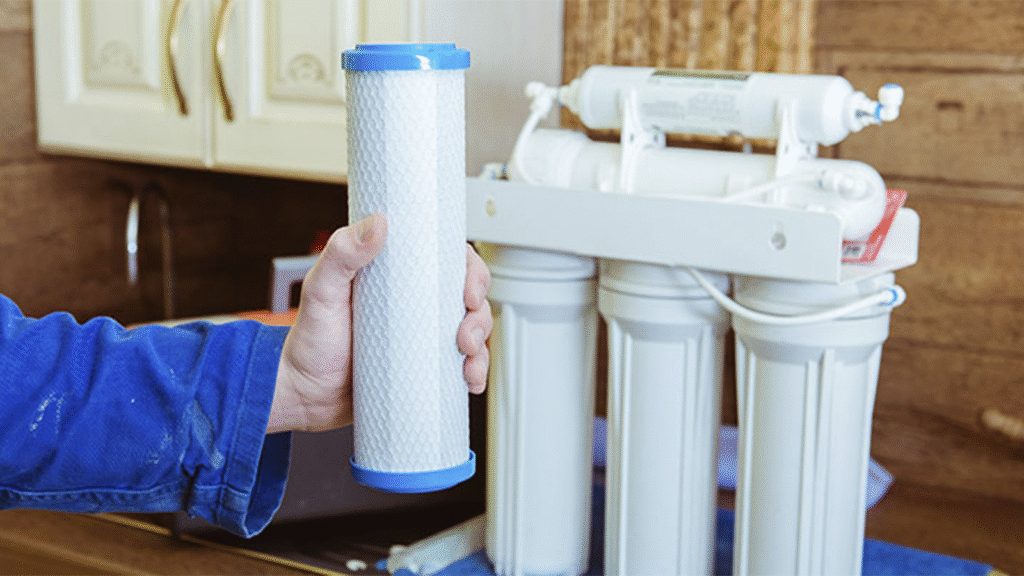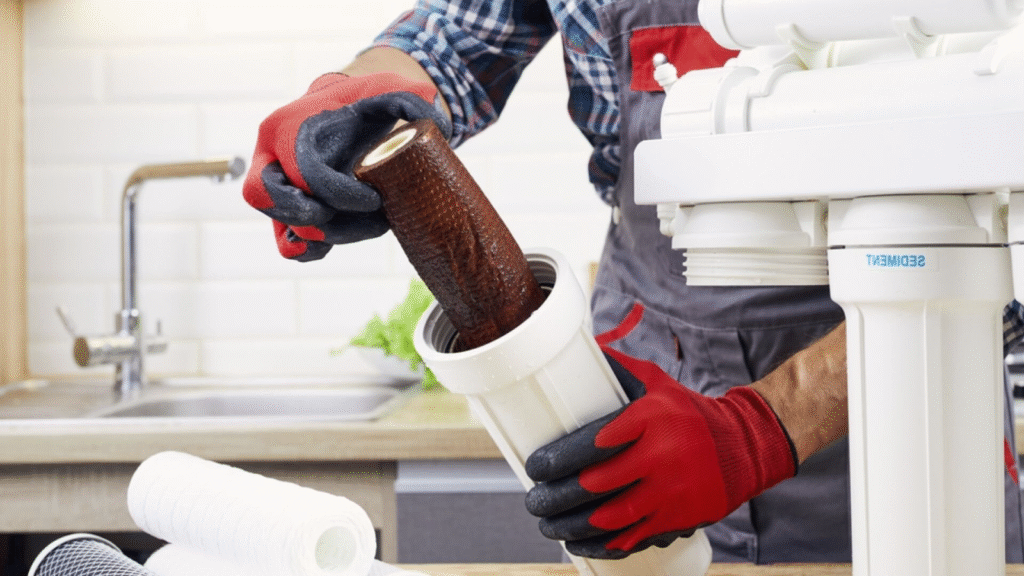Why is my water tasting weird again?
That’s the question Sarah asked herself one chilly Wednesday morning in her Edmonton kitchen.
She just poured a glass of water from the tap. It had a faint metallic tang. Her shower pressure had dropped again. Her laundry came out stiff. And she was starting to notice the return of that stubborn white residue on her faucets… the kind she thought she would leave behind after installing her water softener.
What changed?
After a quick search and a 10-minute call with her local technician, the answer was surprisingly simple: her filter needed replacing.
Just like furnace filters or coffee pods, water softener filters don’t last forever, and letting them run past their prime can quietly undo all the benefits your system offers.
If you’re like Sarah and wondering whether it’s time for a water softener filter replacement in Edmonton, this guide is for you.
Table of Contents
ToggleWhy Replacing Water Softener Filters Matters (Especially in Edmonton)
Edmonton’s water is naturally hard, averaging between 150–300 mg/L of calcium carbonate. That’s well above the national threshold for hard water, which starts at 121 mg/L.
Water softeners are essential in this region, but only if they’re maintained properly, and the filter is your first line of defense.
Failing to replace your filters can result in:
- Decreased water softening efficiency
- Damage to your system’s resin bed
- Lower water pressure
- Contaminated drinking water
- A return of dry skin, spotty dishes, and appliance buildup
Sarah’s Story: What Tipped Her Off
Sarah’s water softener was installed 18 months ago by a local company. The technician told her to replace the pre-filter every 6–12 months, depending on use. But, like many of us, she filed that detail away and forgot.
Her first signs?
- Dry skin and dull hair after showers
- A gritty film in her glass kettle
- Salt levels are depleting faster than usual
- Her coffee started tasting… strange
Only after running through other possibilities: salt bridging, regeneration cycle issues, even the water supply itself, did she realize: it was the filter all along.

Types of Water Softener Filters (and Their Replacement Frequency)
Let’s break down the common types of filters found in water softener systems, and when they typically need replacing.
| Filter Type | Purpose | Replacement Frequency |
| Pre-Filter (Sediment) | Captures sand, silt, rust | Every 3–6 months |
| Carbon Filter | Removes chlorine, organic matter | Every 6–12 months |
| Resin Beads | Performs actual ion exchange (softening) | Every 10–15 years (or sooner if fouled) |
| Reverse Osmosis Membrane (if combined) | Removes dissolved solids | Every 2–3 years |
| Iron Filter (Optional) | Removes iron specifically | 12–24 months |
Note: These are general timelines. In Edmonton, with high mineral content, filters may clog faster, especially during winter when demand spikes.
Signs It’s Time to Replace Your Filter
Don’t wait for your system to fail. Watch for these early warning signs that your water softener filter is overdue for replacement:
1. Drop in Water Pressure
Filters that clog up with sediment restrict flow, especially if you have a pre-filter. Showers take longer. Faucets feel weaker.
2. Return of Hard Water Symptoms
Dry, itchy skin. White scale on taps. Stiff laundry. If these are reappearing, the filter may be letting minerals slip through.
3. Cloudy or Odd-Tasting Water
Water that smells earthy, metallic, or just “off”? That’s a common sign of carbon filter fatigue.
4. Unusual Salt Consumption
If you’re topping up your salt more frequently, your resin bed might be overcompensating for an ineffective pre-filter.
5. Visual Clues
If you remove the housing and see:
- Rust-colored buildup
- Visible clogs
- Slimy or discolored material
…it’s time.
How to Replace a Water Softener Filter (Step-by-Step)
Let’s walk you through a basic filter replacement. This example uses a standard sediment pre-filter system.
Always turn off the water supply and unplug the softener before starting.
What You’ll Need:
- Replacement filter cartridge (check model)
- Filter wrench
- Towel or small bucket
- Silicone grease (optional, for o-rings)
- Clean gloves
Step 1: Shut Off Water Supply
Locate the bypass valve and turn it to “bypass” to isolate the unit.
Step 2: Release Pressure
Open a faucet to release built-up pressure before removing the filter.
Step 3: Unscrew Filter Housing
Use the filter wrench to carefully unscrew the canister. Water may spill; use a towel or bucket.
Step 4: Remove Old Filter
Take out the used cartridge. Examine it for rust, discoloration, or slime.
Step 5: Clean the Housing
Use warm water and mild dish soap to rinse the housing. Avoid bleach unless the manufacturer recommends it.
Step 6: Insert New Filter
Place the new filter in, making sure it’s seated properly. Add a touch of silicone grease to the o-ring if needed.
Step 7: Reassemble and Test
Screw the housing back on. Turn the water back on slowly. Check for leaks. Run water to clear any air pockets.
Done!
Pro Tips:
- Just like an oil change or air filter swap, this is an easy-to-forget chore. Mark your calendar for 6 months out, or better, tape the date to the filter housing itself.
- In Edmonton, winter often causes increased mineral content in municipal water due to changes in runoff and supply sources. If your filter is already nearing the end of its life, these seasonal shifts can push it over the edge. That’s why many local experts recommend replacing filters every 4–5 months during winter, especially in older homes or households with high water usage.
FAQ: Water Softener Filter Replacement in Edmonton
Q1: Can I replace the filter myself, or do I need a technician?
Most pre-filters and carbon filters are DIY-friendly. However, for resin tank cleaning or advanced filtration (like iron filters or RO membranes), it’s smart to call a pro.
Q2: How much does it cost to replace a filter?
- Sediment/Carbon: $20–$50 per filter
- RO membrane: $60–$100+
- Technician visit (if needed): $100–$150 in Edmonton
Q3: Can I clean the old filter and reuse it?
Generally no. Filters are designed for single use. Reusing them reduces efficiency and increases contamination risk.
Q4: How do I know what filter I need?
Check your system manual or the label on the filter housing. You can also contact your installer or a local specialist.
Quick Checklist: Are You Due for a Filter Swap?
- Have you passed the 6-month mark?
- Are there changes in water taste or pressure?
- Any signs of hard water returning?
- Have you seen sediment in water glasses?
- Is it winter in Edmonton?
If you answered “yes” to two or more, it’s time.
Don’t Let a $20 Filter Cost You a $200 Repair
Sarah nearly spent hundreds diagnosing her water softener before realizing it was just a $35 filter.
Sometimes, the smallest part of the system protects the whole investment. Staying proactive doesn’t just save you hassle; it saves money, extends appliance life, and keeps your water softener working like new.
If you’re unsure where to start, reach out to Water Softener Edmonton, who can walk you through a filter plan based on your system type, home size, and seasonal needs.
Final Word
Water softeners work hard, especially in Edmonton.
But even the best system is only as good as its filter.
So whether you’re sipping that morning glass, rinsing your baby’s clothes, or filling your kettle, remember: clean, soft water starts with knowing when and how to replace your filters.
And if Sarah’s story feels familiar?
You’re not alone, and you’re just one replacement away from better water again.



